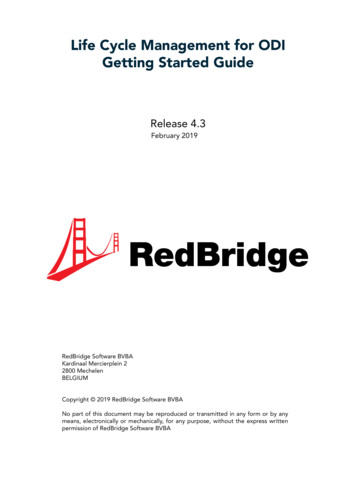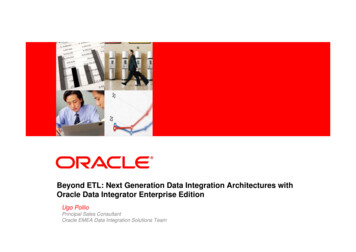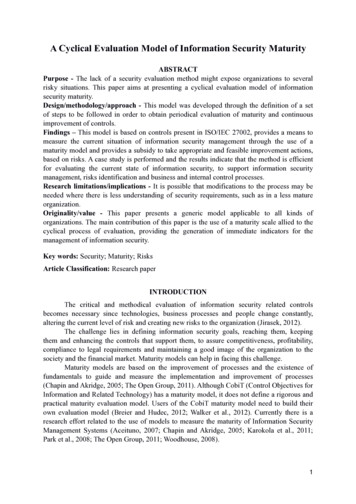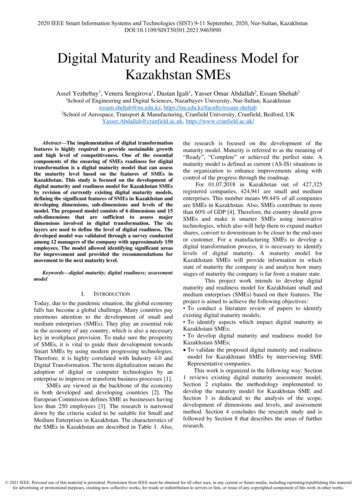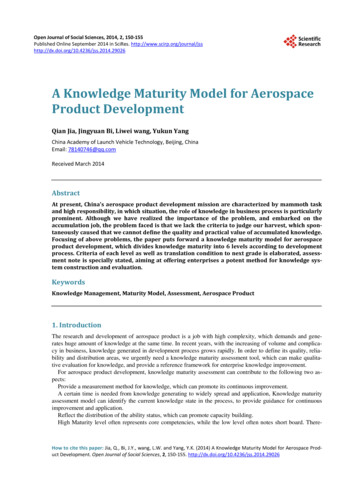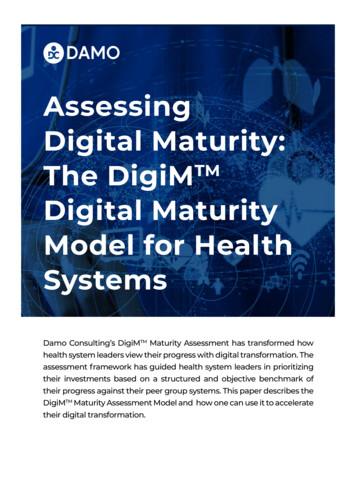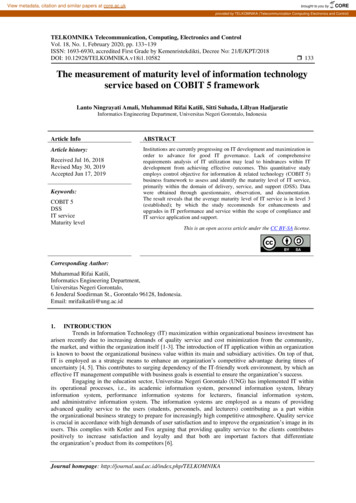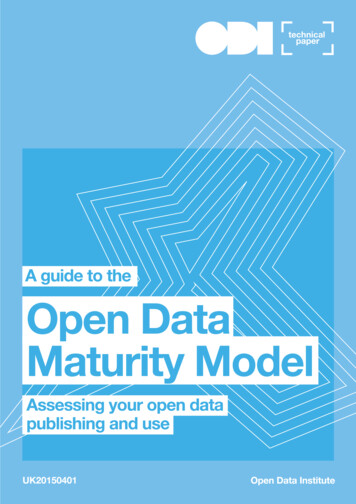
Transcription
technical1Open Data Maturity Model Open Data Institute 2015
Table of Contents2How to view and download the Open Data Maturity Model3Executive summary3Foreword3Introduction Background and history Developing the model Acknowledgements5Overview of the Open Data Maturity Model How is the model structured? How does the model relate to existing work? What is the scope of the model? How can the model be applied?8The five maturity levels10The five organisation themes and related activities11The two aspects of open data practice - publication and reuse12How to perform an assessment Setting an assessment process Prioritising and aligning your activities12Theme 1. Data management processes Building a process to support data release Developing standards and adoption Developing data governance Managing sensitive data15Theme 2. Knowledge and skills Developing open data expertise Knowledge management20Theme 3. Customer support and engagement Developing an engagement process with data reusers Documenting your open data Building a reuser support process Creating open data community norms23Theme 4. Investment and financial performance Ensuring financial oversight Developing dataset valuation processes Building open data into procurement practices27Theme 5. Strategic oversight Shaping open data strategy Asset catalogue management30Open Data Maturity Model Open Data Institute 2015
How to view and download the Open Data Maturity ModelThe Open Data Maturity Model is available to explore online and download as a Google Doc,Excel file and PDF at: xecutive summaryThe Open Data Maturity Model is being developed by the Open Data Institute and the Departmentfor Environment, Food & Rural Affairs to help organisations assess how effectively theypublish and consume open data.The model supports the assessment of operational and strategic activities around open data,provides guidance on potential areas for improvement, and helps organisations comparethemselves against one another to highlight their respective strengths and weaknesses, adoptbest practices and improve their processes.The model is based around five themes, each representing a broad area of activity: datamanagement processes, knowledge and skills, customer support and engagement,investment and financial performance and strategic oversight. An assessment grid helpsorganisations identify their levels of maturity for each of the activities.Organisations can use the model to set themselves appropriate goals based on their currentmaturity, resourcing and anticipated benefits. To achieve the full, long-term benefits of opendata, organisations must take steps beyond basic data publication, the assessment of opendata publishing and consumption is a strong starting point.While the model has been initially developed for a UK public sector audience, it can also beapplied to any type of organisation with little or no modification, whether they are alreadypublishing or consuming open data, or are planning to do so.ForewordThe first challenges that many organisations face when becoming open data publishers aretechnical, largely centred around how to publish data in easy-to-use formats with clear licensing.If reusers are to have reliable, sustainable access to published data then publishers will need3Open Data Maturity Model Open Data Institute 2015
to consider these challenges as well as the strategic, financial and operational impacts ofmaking their data open.Understanding this organisational change is an important aspect of becoming an effectiveopen data publisher. Similar changes take place as organisations begin to reap the benefitsof reusing open data to reduce costs, increase efficiency and to drive innovation.Organisations are at different stages in this open data journey. Some are only just beginning topublish data, while others have already undergone significant changes towards a more “openby default” model. Many are seeking guidance about how to take the next steps in their journey.The goal of this Open Data Maturity Model is to highlight issues commonly encountered bypublishers, and provide a means for organisations to assess and improve their effectivenessas publishers and consumers of open data. The maturity model provides a framework forunderstanding the different areas of organisational change towards open data, while alsoidentifying the benefits of that change.4Open Data Maturity Model Open Data Institute 2015
IntroductionThe Open Data Maturity Model is being developed to support organisations in assessing theireffectiveness in publishing and consuming open data.While the model has been initially developed for a UK public sector audience, it can also beapplied to any type of organisation with little or no modification, whether they are alreadypublishing or consuming open data, or are planning to do so.The model: supports assessment of the effectiveness of an organisation in its operational andstrategic activities around open dataprovides guidance to organisations on potential areas for improvementcompares organisations to highlight their respective strengths and weaknesses,support wider adoption of best practices and help improve processesWith these purposes in mind, the model can be used by both data managers working withinindividual business units and senior management with oversight on data management andgovernance practices.The model should not add unnecessary burden to organisations that are publishing or reusingopen data, rather, they can use it to set themselves appropriate goals based on their currentmaturity, resourcing and anticipated benefits.To achieve the full, long-term benefits of open data, organisations must take steps beyondbasic data publication, the assessment of open data publishing and consumption is a strongstarting point.Within the UK public sector the Open Data Maturity Model should be particularly relevant toorganisations responsible for managing aspects of the UK National Information Infrastructure1.These organisations should have a clear view of their open data maturity and have appropriatetargets for development.1National Information Infrastructure, l-informationinfrastructure accessed on 2015-03-195Open Data Maturity Model Open Data Institute 2015
Background and historyThe Open Data Maturity Model was developed as a joint project between the Open DataInstitute2 (ODI) and the Department for Environment, Food & Rural Affairs (Defra)3.The Defra Network transparency panel identified a need to measure the effectiveness andtransparency of the Defra network organisations as open data publishers. The panel felt thatbetter understanding of relative maturity would help to drive the organisational change requiredto promote open data publishing.Defra and the ODI were awarded funding to develop a maturity model and a prototypeassessment tool under the Release of Data Fund4 administered by the Cabinet Office and theOpen Data User Group.Developing the modelWe began to develop the Open Data Maturity Model by drawing on the results of a series ofrequirements workshops attended by data managers and open data experts from the UKgovernment and wider open data community.The attendees discussed a number of key themes thought to be components of data governanceand management practices. Each theme was reviewed to identify key challenges, outputs (suchas policy documents), and evidence for progression.The requirements workshops were supplemented with additional research on data governanceand management practices. Some comparative research on the design and development ofmaturity models was also drawn on during the analysis.We published draft versions of this document and the assessment grid for public comment.We reviewed feedback and incorporated it into the final documents.We intend to revise and extend the model in future based on experience with applying it inreal-world use. An online tool will also be provided to support organisations in assessing theirmaturity.2Open Data Institute, http://theodi.org, accessed on 2015-02-043Department for Environment, Food & Rural Affairs, mentfor-environment-food-rural-affairs, accessed on 2015-02-044Breakthrough Fund and Release of Data, rough-fund-andrelease-of-data-fund, accessed on 2015-02-46Open Data Maturity Model Open Data Institute 2015
AcknowledgementsDefra and the ODI would like to jointly thank all of the attendees of the requirements workshopsfor their contributions to the development of the maturity model. We would also like to thankeveryone from across central and local government, agencies and other organisations whoprovided feedback on the draft documents. The contributions and ideas were extremelyvaluable.The funding and support for the project from the Cabinet Office and the Open Data User Group(ODUG)5 were essential in making the model a reality.5207Open Data User Group, r-group, accessed on 2015-03-Open Data Maturity Model Open Data Institute 2015
Overview of the Open Data Maturity ModelA ‘maturity model’ generally provides a framework that allows an organisation to assess howwell its processes conform to industry best practices. The model acts as an independentbenchmark that allows organisations to score their maturity, usually in a number of related areas.The Open Data Maturity Model has been designed to specifically focus on how open datapractice impacts on an organisation.A completed assessment against this model will give an organisation a maturity score for anumber of important activities, namely how data is released, how it is governed and howdatasets are valued. The score will reflect the maturity of the organisation’s processes in aspecific area and can be used to identify areas of improvement and set measurable targets.How is the model structured?The Open Data Maturity Model consists of 15 organisational activities, e.g. data release processesor adoption of community norms, which are each explained in this paper.The activities are grouped into five themes that categorise the activities. These have been derivedfrom the categories used in a “balanced scorecard”6 to assess and monitor organisationalperformance. This reflects the goal to assess the variety of ways in which open data practicemay impact on an organisation.Activities can also be grouped according to whether they relate to the publication of data, reuseof data or both of these areas. These are referred to as aspects.The overall structure of the model is reflected in the assessment grid that accompanies this paper(see Appendix). We recommend that you review the grid alongside this document.An organisation will assess its maturity against each of the activities in the model, producing amaturity score from 1-5 for each activity. These five maturity levels use names drawn from similarfive-point schemes in other maturity models: initial, repeatable, defined, managed, and optimising.Each of the maturity levels has a definition which describes the key characteristics of an activityoccurring at that level. For lower scores, activities are likely to be ad hoc, while at higher levelsprocesses will be more refined.68Balanced Scorecard, http://en.wikipedia.org/wiki/Balanced scorecard, accessed on 2015-01-30Open Data Maturity Model Open Data Institute 2015
To help motivate organisations to progress through the levels of maturity, each of the activitiesis associated with a description of the beneficial effects that follow from increased maturityin the activity.The various elements of the model are covered in more detail later in the paper.How does the model relate to existing work?While there are other efforts7 8, to assess maturity of data management and governance practices,these existing models do not adequately address the issue of open data.The Open Data Maturity Model has been developed with reference to existing maturity modelsthat measure other areas of organisational maturity9. Organisations that are already applying othermaturity models should find that the Open Data Maturity Model aligns well with other approaches.The model also complements the Open Data Certificates, which provide publishers with feedbackon how effectively they are publishing individual datasets10. The Open Data Maturity Modelassesses effectiveness at the organisational level. Mature organisations will be able to routinelypublish datasets that are likely to gain a higher level of certification.What is the scope of the model?The Open Data Maturity Model is not intended to offer a prescriptive description of exactly howorganisations should publish or reuse open data. Rather, the model focuses on the generalbehaviours that an organisation should exhibit and the processes it should adopt.For example, the model highlights data governance as an important organisational activity.It suggests that a robust, well-defined and widely deployed data governance process is acharacteristic of a mature open data organisation. The model also notes that a well-designeddata governance process will involve clear ownership over data and cover elements such as dataquality management. However, it does not recommend a specific data governance process thatorganisations should adopt.7IBM Data Governance Council Maturity Model, ge wpdata gov council maturity model.pdf, accessed on 2015-03-258Stanford Data Governance Maturity Model, files/StanfordDataGovernanceMaturityModel.pdf, accessed on 2015-03-259See, for example: Capability Maturity Model, http://en.wikipedia.org/wiki/Capability Maturity Model, accessedon 2015-01-30109Open Data Certificates, https://certificates.theodi.org, accessed on 2015-03-19Open Data Maturity Model Open Data Institute 2015
Individual organisations should implement these processes based on their needs. It would beoverly prescriptive for this model to recommend processes that could be usefully applied inevery organisation.While we expect that best practices will eventually emerge for many of these areas of activity,that detail is outside of the scope of the maturity model.How can the model be applied?The structure of the model allows it to be applied in several ways: It can be used to produce a single maturity score providing a summary of anorganisation’s overall maturityIt can produce scores for individual themes, allowing an organisation to focus onbroad areas that may need specific improvementIt can produce scores for individual activities, giving a more detailed assessment ofan organisationIt can be used to assess maturity as an open data publisher or as an open dataconsumerImportantly, we intend the model to be actionable: it should be possible to use the model toboth set and monitor goals for organisational development, and as a source of guidance onimplementing improvements.The five maturity levelsThe Open Data Maturity Model is based on five levels that represent the different states throughwhich an organisation will pass as it matures. Advancing to the next stage involves creating,developing and refining specific business activities and processes.Setting aside the details of individual activities, the levels themselves can be characterised asfollows:1. Initial — the desirable processes are non-existent or ad hoc, with no organisationaloversight.2. Repeatable — processes are becoming refined and repeatable, but only within thescope of individual teams or projects. There are no organisational standards.3. Defined — processes are standardised within the organisation based on best10Open Data Maturity Model Open Data Institute 2015
practices identified internally or from external sources. Knowledge and best practicesstart to be shared internally. However the processes may still not be widely adopted.4. Managed — the organisation has widely adopted the standard processes and beginsmonitors them using defined metrics.5. Optimising — the organisation is attempting to optimise and refine its process toincrease efficiency within the organisation and, more widely, within its business sector.Broadly, the levels represent an increasing level of sophistication in the organisation: moving from ad hoc uncontrolled processes to those that are repeatable, standardisedand well-managedmoving from a reactive to a proactive approach within a particular area of activitymoving from isolated expertise, e.g. individuals championing open data, through towider organisational supportThe five organisation themes and related activitiesThe model is based around five themes. Each of the themes represents a broad area of activitywithin the organisation: 11Data management processes — identifies the key business processes that underpindata management and publication including quality control, publication workflows,and adoption of technical standards.Knowledge & skills — highlights the steps required to create a culture of open datawithin an organisation by identifying the knowledge sharing, training and learningrequired to embed an understanding of the benefits of open data.Customer support & engagement — addresses the need for an organisation toengage with both their data sources and their data reusers to provide sufficientsupport and feedback to make open data successful.Investment & financial performance — covers the need for organisations to haveinsight into the value of their datasets and the appropriate budgetary and financialoversight required to support their publication. In terms of data consumption,organisations will need to understand the costs and value associated with theirreuse of third-party datasets.Strategic oversight — highlights the need for an organisation to have a clear strategyaround data sharing and reuse, and an identified leadership with responsibility andcapacity to deliver that strategy.Open Data Maturity Model Open Data Institute 2015
Each of these themes have been broken down into several activities that describe the behavioursand processes that the organisation should carry out.The assessment grid identifies how organisations at different levels of maturity will carry outeach of the activities. The majority of this document provides more detail on the themes andactivities.The two aspects of open data practice - publication and reuseWe expect that a mature open data organisation will be both a consumer and publisher of opendata, although the overall balance is likely to vary across organisations. Some organisationsmay primarily publish rather than reuse data, while others may primarily consume data andhave little or no published data.Some activities within the maturity model apply to both the publication and reuse of data, whileothers are clearly focused on one of those aspects of open data practice.To help organisations focus on the elements of the model that are most applicable to them,the assessment grid identifies whether the individual activities are associated with one or bothof the following aspects: Data publication — addresses the organisational activities and processes thatsupport the creation and management of datasets that are made accessible underan open licence.Data re-use — is concerned with the processes that support the effective reuse ofthird-party datasets.How to perform an assessmentThe Open Data Maturity Model provides a framework for assessing organisational maturityacross a range of activities. As part of carrying out a maturity assessment, an organisationshould attempt to score itself against all of these activities. This will produce a completeassessment of open data maturity and support benchmarking with other organisations. Howeverwe do not expect that all organisations will obtain the maximum score in all activities.Some elements of the model will be more applicable to certain organisations. For example,an organisation handling sensitive personal data will likely focus on gaining greater maturity12Open Data Maturity Model Open Data Institute 2015
in desensitising data. In contrast, an organisation that manages only non-personal referencedata will not require a high maturity in this area.Some organisations may be creating and managing data as part of their primary task or goal,while others may only be generating data as a side-effect of other actions. These differenceswill affect how important it is to attain a high level of maturity and, accordingly, the level ofinvestment appropriate to support improvement.Organisations should determine the target maturity that is appropriate for their specific goalsand purpose. As an organisation gains value from its open data practice this may justifyadditional investment, and a subsequent raising of targets to help unlock further benefits.Assessment and improvement should be an iterative process.If an organisation is transparent about its current open data maturity and targets it may helpthe wider community understand what it can expect from that organisation in terms of its opendata practice. Transparency can also help support benchmarking across organisations.Importantly, the model is not meant to hinder the release or use of open data. For example, alow maturity score for a data release process should not preclude publishing open data. Theactivities described in the model should provide a roadmap for improvement not a list of tasksto complete before data is released. Indeed, it is desirable for organisations to experience lowlevels of maturity so that they develop processes that are appropriate for the organisation.Attempting to leapfrog to high maturity levels may result in imposing processes that do nottake into account the culture, environment or particular needs of the organisation.Setting an assessment processThe following process outlines a recommended approach for conducting a maturity assessment:1. Identify an organisational lead — a thorough assessment will likely require inputfrom across the organisation but there should be a clear lead who coordinates theassessment.2. Identify the scope — the maturity model can be used to assess individual departmentsor a whole organisation. We recommend beginning with an assessment of the wholeorganisation.3. Identify key participants — which people in the organisation may need to beinvolved to help answer specific questions or support the evaluation?4. Assess and score each activity — using the assessment grid, review each of theactivities and identify the level of maturity achieved by the organisation. To qualify at a13Open Data Maturity Model Open Data Institute 2015
5.6.7.8.specific maturity level, the organisation should exhibit all of the described behaviours.Set appropriate targets — having conducted a baseline assessment, identifyappropriate targets for improvement. This will involve either maintaining or improvingthe score for specific activities.Develop action plan —based on the results and the targets, identify a plan forimplementing improvements.Circulate results — share the results, targets and action plan within the organisation,including to those involved in supporting the assessment. Senior management supportand review will be essential in helping to implement improvements. An organisationmay also wish to share its results more widely.Set date for next assessment — the action plan should set a date for a furtherassessment. This will allow the organisation to monitor its progress. We recommendconducting regular annual assessments.Prioritising and aligning your activitiesThe assessment grid and this guidance document describe a number of activities. The orderin which these are presented reflects a rough progression from operational concerns (e.g.technology, standards) through to strategic issues (e.g. finance and policy). However there isno underlying assumption that any of the activities have a higher priority or value than others.Also, in practice, the activities will relate to one another. For example, developing an internalasset catalogue to help create strategic oversight may also progress good data governanceand data release processes. Similarly, developing a dataset valuation process may help informfinancial planning and prioritising releases.An organisation may choose to assign its own priorities to the activities in the model: 14When conducting an assessment it may be useful to prioritise the review of certainactivities, e.g. to review well-defined and understood areas first or to align with otherorganisational priorities.When setting targets and developing an action plan the organisation may wishto prioritise certain activities for improvement. Some organisations may prefer toimplement changes in a top-down style (perhaps focusing first on strategy andoversight) while others may prefer a bottom-up approach.Open Data Maturity Model Open Data Institute 2015
Theme 1. Data management processesActivityDatareleaseprocessAspectLevel 1 InitialLevel 2 RepeatableLevel 3 DefinedPublicationLittle or nopublished opendata.Specificprojects orproducts mayhave defineda repeatableprocess for [.]There is arepeatableorganisationwide standardrelease processfor [.]Datasets thatare published[.]Level 4 ManagedAll datasetsare releasedaccording tothe standardorganisationalprocess.Level 5 OptimisingTheorganisationcollects andmonitorsmetrics onits releaseprocess, [.]BeneficialeffectsReduceoverheadsassociated withdata releases.Within a mature open data organisation, a number of business processes will underpin theeffective management of datasets. These processes will support both the release and reuseof open data.Strong data governance helps to ensure that an organisation effectively maintains its dataassets. Managing data quality is important regardless of how data is subsequently licensedand shared.However some data management practices may be less applicable for open data. For example,managing access and security is not a concern given that open data is accessible to anyone,by definition.Conversely, there are practices that are particularly relevant for open data. These includeissues such as: anonymisation and aggregation of data to remove sensitive informationredaction of personally or commercially sensitive datathe adoption of best practices that ensure that published data can be easily reused by third-partiesWith this in mind, this theme highlights data management and governance practices that areparticularly relevant to open data. But it is recommended that this assessment is made in thecontext of a wider evaluation of data governance within the organisation.15Open Data Maturity Model Open Data Institute 2015
Building a process to support data releaseA mature open data organisation will have a well-defined process to support the publicationof open data. The process will address the technical aspects of publishing both new datasetsand updates to existing datasets in a timely manner.The release process will be well documented and address key issues such as: the technical infrastructure used to support a release, e.g. a specific data platformor portalthe creation and maintenance of dataset-specific metadatathe internal processes and workflows that support review and packaging of datafor releasethe syndication of datasets and/or metadata to third-party data catalogs andplatformsThe organisation’s standard process will describe the key steps involved in a release, identifyingresponsibilities for ensuring releases happen in a timely manner and to a high standard.Individual datasets may be released using a methodology that adapts the organisation-widestandard based on the needs of the specific dataset or product.Key metrics that may be collected about this process include: the number of datasets releasedthe number of datasets released to schedulethe number of datasets being regularly updatedthe mean time between internal updates being made to a dataset and thoseupdates being shared with othersMoving from ad-hoc approaches to data releases to a repeatable process will bring anumber of benefits, including: 16simplifying release of new data through reuse of existing workflows and toolsmaking it easier for reusers to find and use a variety of datasets from theorganisationclarity around whether datasets are being released in line with corporate objectivesOpen Data Maturity Model Open Data Institute 2015
Developing standards and adoptionMature organisations will benefit from both the use of open standards for formatting dataand the adoption of industry standard identifiers in their datasets.These benefits for publishers include: available open source tooling to support managing dataeasy recruitment of specific technical expertisereduced burden of maintaining and documenting bespoke standardsincreased adoption and use of published dataAdoption of standards also has benefits for reusers of open data: datasets published in industry or de facto standard formats are easier toconsumedatasets that use common identifiers, such as codes for geographical areas, aremore easily compared and combinedreusers can easily find relevant data and documentation by looking up identifiersreusers can more easily process datasets when they are published using standardmetadata and packaging formatsWhen standards are widely adopted it benefits everyone as costs can be lowered through theuse of common, standard tools. Datasets that are linked together can be more easily analysedand combined more flexible ways.A mature open data organisation will define the technical standards that it will use whenpublishing its data. These standards will address: the data formats (e.g. CSV, JSON, KML) used to structure the datathe access methods (e.g. an API) used to make data availablethe means by which the data is structured, e.g. th
The Open Data Maturity Model is not intended to offera prescriptivedescriptionof exactly how organisations should publish or reuse open data. Rather, the model focuses on the general . For example, the model highlights data governance as an important organisational activity. Open Data Maturity Model Open Data Institute . Open Data Maturity .
